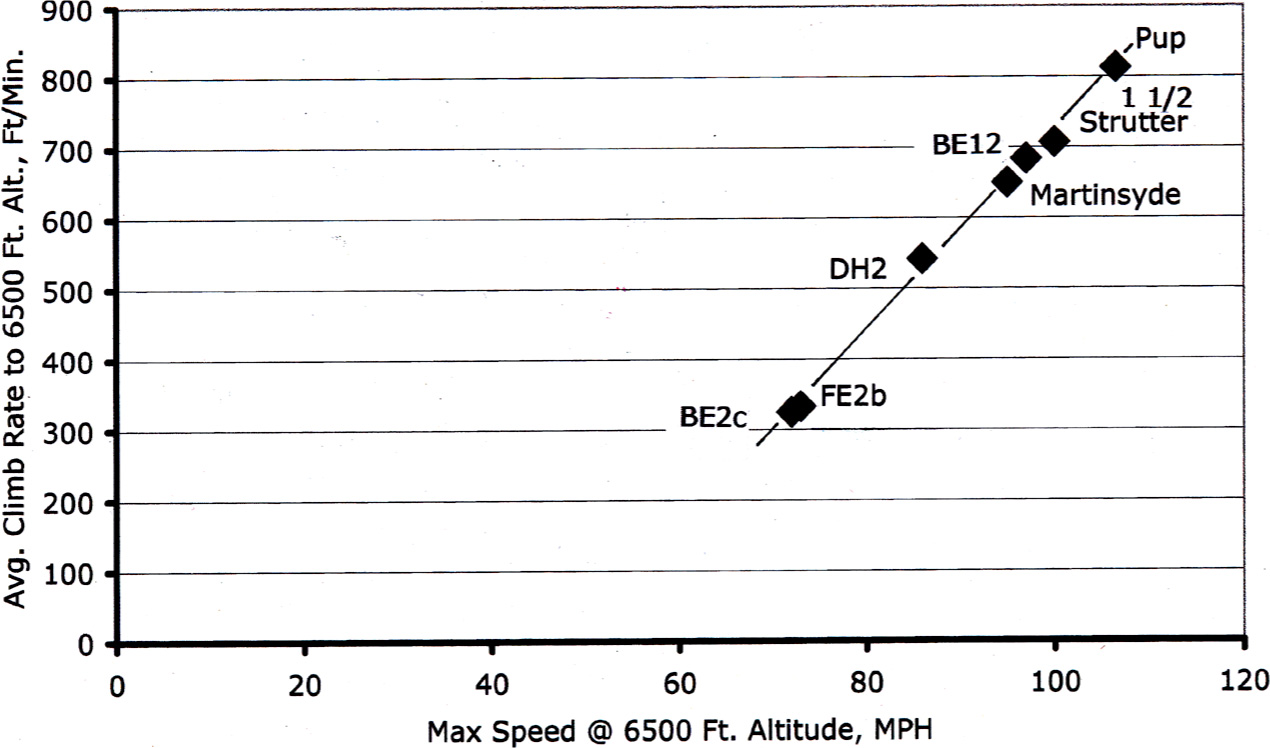
Maneuverability Triumphs, 1917
Beyond noting his first sighting of a Sopwith Pup, Richthofen paid it little attention for it came at a time (January 1917) crowded with important professional achievements. In recognition of his 16 victories, he received the Pour le Mérite award (‘the Blue Max’), Prussia’s highest military award. Simultaneously, another form of award came with his appointment as commander of Jagdstaffel 11 [i.e., Pursuit Squadron 11; abbreviated: Jasta].
Of the two awards, he preferred the medal,1 for it was that rarest of gifts – one without drawbacks. In contrast, the command position was laden with problems. It would take time and public relations pressure before he was able to describe this task as “delightful.”2
One of his many command concerns was the assembling of a logical approach to the issue of maneuvers and maneuverability – an issue highlighted by the Pup. Before the Pup, Richthofen could afford to dismiss aerobatics and trick flying, opting instead for speed as a fighter’s most important property,3 and straightforward attack from behind as the best tactic. Given the reality of the Pup, he was forced to consider a fresh enemy approach – one that combined good speed, a high climb rate and superb maneuverability. How was this to be treated? What should be done in the way of preparation?
A fighting aircraft possessing speed and climb capabilities roughly matching that of its enemy could well force the resulting action, pushing some preferred form of combat upon its opponent – such as the aerobatic duel. Under these conditions maneuverability couldn’t be ignored. Might not combat take on an entirely different perspective?
Performance: British Fighting Aircraft 1914–1917

Of all machines encountered by Richthofen in the early war period, the Sopwith Pup offered the best climb and speed performance.Source: Original plot by author from data, H.A. Jones, The War in the Air Volume 7 (Appendices) (Oxford: Oxford University Press, 1937) Appendix 27.
Performance: British Fighting Aircraft 1914–1917
Trend Lines Only

Aircraft performance could be altered to emphasize either climb or speed. The actual straight line performance output over the years suggests satisfaction with the blend. Source: Original plot by author, based on previous performance sketch.
In 1916, the British had no such machine, and the question was entirely academic. Boelcke’s truisms proved sufficient to deal with the resulting straightforward form of combat. Well and good, but what of the Pup and 1917? As a first hurdle, just how good was the Pup? Did it offer enough performance to qualify as a serious contender?
Accepting speed and climb rate as key performance criteria, a plot of official values4 for early British war machines shows the striking superiority of the Pup. One would expect almost any 1917 machine’s performance to exceed that of the elderly BE2c and FE2b, but the Pup bettered more recent machines as well. Even the more powerful and much vaunted BE12 was easily bested. Not only did the Pup’s speed and climb values top those within the group but as a bonus, the aircraft offered extraordinary maneuverability as well.
The straight line form of the performance results testifies to fixed notions about the relative importance of climb and speed. Over many months of combat, we might expect either speed or climb to be sensed as more significant than its rival feature, and as a result, newer and more powerful aircraft designs to emphasize one quality over the other. In this case the resulting performance curve would bend slightly as it moved towards the right, either drooping downwards towards the horizontal axis to grant a bit more speed or twisting upwards to reflect the belief that climb was more important. The ease of making changes in the field – much could be achieved by simply switching propellers – acted to promote performance modification. In short, one might anticipate major changes to appear in the output curve as newer aircraft arrived. Instead, despite the ease of change, the resulting line bends neither up or down. Though British hunger for more total performance was desperate, that special blend of factors defining a given performance level – the mixture of climb and speed – was viewed as just right.
Whether its design represented an optimum combination of speed and climb or not, there was no doubt about German respect for the Pup. Details from captured aircraft were assembled by Idflieg (Air Service Intelligence) and published as instructional aids for interested buffs and technical workers.
Of course, German praise had limits. Speed was still king and as pointed out by Leutnant Werner Voss5 the Pup was slower than the standard Albatros fighter, though superior in climb and “handling”, i.e., maneuverability. Lacking in speed, the Pup could not quite force an Albatros to fight on its own terms – the German fighter could always speed away if the odds seemed bad. Given this limitation, what did maneuverability offer, i.e., maneuverability combined with a lower top speed?
Consider a simple case: maneuverability in defense; not the complexities of the circular duel, but defense against a straightforward, classic attack from above and behind. The cardinal rule of defense against this possibility was simple: “never let the enemy machine get behind you.”6 As usual with sound advice, the sticky part was in the implementation – in this case, preventing an enemy from occupying a superior attack position. Given enough combat experience, fighter pilots inevitably encountered an enemy located in the perfect above and behind position. What then?
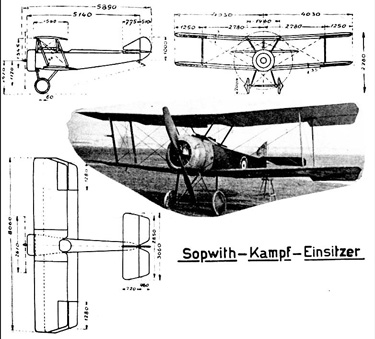
The Sopwith Pup’s extraordinary performance led to a German study of its design. Source: Flugsport, June 1917, pp.365, 367.
The Right Angle Defense (top view)
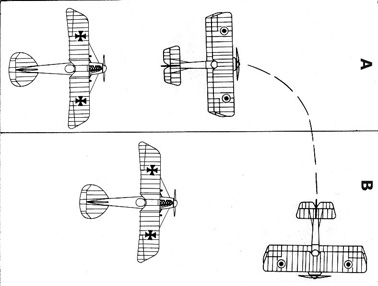
With an enemy behind you (A), a good move is to turn (B) presenting him with a right angle shot. Odds are that his bullets will fall behind. See text. Source: Original sketch by author to illustrate views William A. Bishop, Winged Warfare (London: Hodder and Stoughton, 1918) p.232, aircraft drawings in L’Aérophile, June 1917, p.203 and Flugsport, June 1917, p.365.
To survive, the best move was a turn; if possible, a climbing turn to the right, so as not to lose altitude. Once flying at an angle to incoming fire, the attacking enemy’s shooting accuracy fell off, for gunnery precision depended upon knowing and allowing for the crossing speed. This was not easy, for in changing position from that dead ahead of an attacking Albatros, to a path at right angles, the Pup’s crossing speed varied every step of the way: sideways velocity changed from an initial barely perceptible motion to full flying speed. Even experts found this judgement extremely difficult. As a result, a quick turn almost guaranteed safety from bullets – true, only momentary safety – but a most useful relief nonetheless.
To bring this off, the key requirement was for speed in turning. Above all, a quick acceleration into the turn was wanted. Here, the lightweight Pup with its concentrated mass (rotary engine, pilot, gun, fuel) was much superior to the heavier weight Albatros. Not only did its greater mass impede any swift change, but the spread out form of the Albatros mass acted to further slow its initial turning capability. The usual combat result was a tendency for Albatros bullets to fall far behind a turning adversary. In sum, an aircraft’s ability to accelerate into a turn, thereby escaping enemy bullets – an important advantage – was one associated with maneuverability.
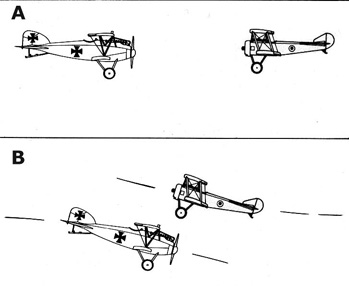
Was seldom used (A) owing to too short a shooting period and the possibility of collision. Pup maneuverability helped make head-on attack practical (B) by offering a longer time for shooting while decreasing the probability of collision. Source: Original sketches by author from description Fighting Instruction Data TNA file # AIR 1/1625/204/89/8 and aircraft drawings in Flugsport, June 1917 and L’Aérophile, June 1917, p.203.
Other special combat cases led to the same pro-maneuverability, pro-Pup conclusion. For example, there was head-on attack, in which opposing aircraft fly and shoot directly at one another. Here the attack form itself included two strong inherent drawbacks: a lack of time available for shooting and the danger of collision. Consider aircraft maneuverability as a factor in making this type of attack feasible.
In head-on attack, aircraft closing speed equaled the sum of both machine’s velocities. At the usual high scout speeds, the intervening space was quickly traversed. If we assume a velocity of 100 mph for each airplane, every passing second reduced the distance between machines by roughly 100 yards.7 If we imagine the pilots opening fire at 400 yards range, only four seconds of shooting was possible before collision. Four seconds was very little. With a machine gun cyclic rate of 10 rounds fired per second, and discounting cooling breaks, the total of rounds fired per gun amounted to less than 40. Assigning two guns to the fighter plane, the firing of less than 80 rounds was possible. As compared to Richthofen’s usual expenditure of some hundreds of rounds to bring down an enemy, 80 bullets were few indeed – and this number does not take into account the necessity for an early cease fire so as to pull away; a matter of sacrificing shooting time to prevent collision. Taking gun cooling and time for evasion into account, a 20 round grand total was likely.
The calculation above was easy to perform and fully supported real life experience. We suspect that Boelcke ignored this form of attack because the numbers were so unprofitable. An attack featuring a low closing speed was obviously a better tactic from the gunnery point of view. Best of all was an attack with a zero closing speed, permitting one to blast away, directly behind a fleeing enemy moving in the same direction and at the same velocity, without any limit to the rounds fired. This was Richthofen’s favorite – for the best of logical reasons.
But what of the head-on attack? The nature of air combat led to plenty of head-on confrontations, wanted or not. What could be done to increase shooting profitability? The key need was for more shooting time. One way to buy more shooting time was to reduce that time required for pulling away. For the lightweight and maneuverable Pup, enjoying a high climb rate, this meant moving into a climb mode and showing a slight gain of altitude – a few feet would do – all within a couple of seconds. Given an alert pilot and a well trimmed Pup, this maneuver was feasible; for the heavyweight Albatros, it was impossible. However, within the same few seconds, something in the way of an altitude drop could be achieved by pointing the Albatros downwards, or by skidding at full yaw. The result was the desired near miss instead of collision, along with a shooting period extended by a second or two for each opponent. Of course, safety depended on pilots knowing the abilities of their machine, in addition to those of the enemy. For the Pup to head downward could produce disaster, as might if an Albatros headed upwards.
RFC instructions were clear:8 “Pull the stick back and zoom over his top wing … pull up, not down … because the Hun generally dives.” And if he didn’t? “You will then only hit him with your undercarriage (i.e., landing gear).” Perhaps, but perhaps not; head-on collision remained a real possibility. Yet, so desperate were the needs and hopes of combat that even these frightening instructions seemed promising. The ability to fire off another ten to twenty rounds was highly significant. In this manner, while far from a complete solution, the Pup with its quick mobility and longer shooting time made head-on tactics more profitable, helping to move a neglected technique into the mainstream.
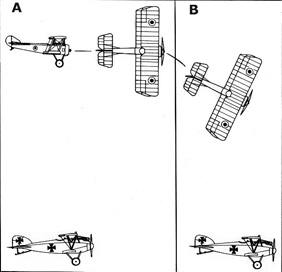
Directly above an enemy Albatros (A) and unable to shoot effectively, the Pup employs a vertical bank and bottom rudder (B) to produce a slow, side-slip descent, properly angled for shooting. Source: Original sketches by author from concept in Notes on Air Fighting, TNA file # AIR 1/2087/ 207/7/38 and aircraft drawings in Flugsport, June 1917, p.365 and L’Aérophile, June 1917, p.203.
Consider another, and quite different tactical problem: that of sitting directly above an opponent, several hundred feet higher, and moving in the same direction at the same speed. Achieved was that desired zero closing speed, but it was of the wrong sort – at different altitudes – and so, worthless. Most single-seater scout aircraft were equipped to shoot only along their axis; i.e., in the direction of flight. This had the advantage of simplifying the setting of gun sights, for the aiming of guns in close combat could be achieved to a considerable extent by aiming the entire airplane. However, there was a disadvantage to this process: it was impossible to shoot at any enemy plane flying along a parallel path.
Given parallel flight paths, the standard solution was for the uppermost aircraft, let’s say a Pup, to dive, directing its bullets just ahead of the unaware Albatros shown. The difficulty consisted of limited shooting time, for the diving Pup gained unwanted speed and overtook his adversary. After a few seconds, collision became a menacing possibility, forcing the Pup to break off contact – likely before a decisive number of shots could be fired.
Pup maneuverability led to another, and better solution.9 Instead of a diving attack, a combination of vertical bank and bottom rudder could be employed to produce a slow, angled, stalled descent that helped keep the Pup’s sights on the enemy. The main gain was an increase in shooting time duration. As a second advantage, the slowly descending Pup was unlikely to overtake its target, ruling out collision. True, the shooting time difference was small, but to a fighting pilot the opportunity to get off ten more rounds could be life saving.
There was a third advantage. The resulting Pup aircraft attitude – in effect a vertical sideslip owing to much bank and yaw – was just right for entering a spin. Should the Pup attack fail, or encounter a furious Albatros brother pilot seeking revenge, it might be wise to do a couple of spin turns and then scoot for home. Official advice was mixed on this point. British flight school advice pointed to the short spin as “ … a good way of getting away from a fight you do not wish to carry on.”10 However, another official source offered doubts:“This is one way of getting an enemy off one’s tail … [but] It is not recommended as one loses such a lot of height … ”11 We suspect that those rich in altitude and hungry for safety were willing to make the trade. For those pilots, Pup maneuverability made quick spins easy and profitable.
Another offensive move made practical through maneuverability was attack from beneath. Here an initial attitude suggesting head-on attack was frequently converted into a very different form: one of bullets from below.
Shooting from down under had two major advantages as compared to a head-on strike. First, the enemy scout plane had no way of replying effectively – his guns were pointed elsewhere. Secondly, the enemy pilot lost his usual personal protection, gained from employing the engine as a barrier. Exposed to incoming fire, it was possible to hit him directly, ending the battle quickly.
To bring this about, RFC instructions were attractively simple: “Dive your machine till you can see the enemy over the top plane. Then pull out and shoot him at an angle from underneath.”12
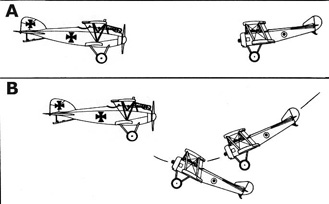
Facing an Albatros head-on at long range (A), a Pup’s best move was to dive and zoom (B), aiming at the vulnerable underside. Source: Original sketch by author from concept Notes on Air Fighting, TNA file # AIR 1/ 2087/207/7/38 and aircraft drawings in Flugsport, June 1917, p.365 and L’Aérophile, June 1917, p.203.
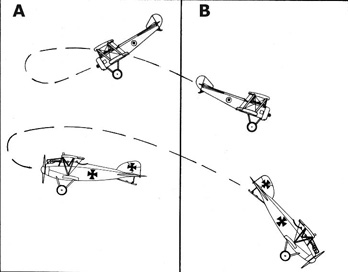
Upon receiving fire from above (A), the Albatros would likely enter a right hand turn–throwing off aim–and then dive steeply. Unable to follow, the Pup had no second act possibility. Source: Original sketch by author from concept in Aerial Fighting 1917, TNA file # AIR 1/920/204/5/885 and aircraft drawings in Flugsport, June 1917, p.365 and L’Aérophile, June 1917, p.203.
Left out was the well-known Albatros tendency to dive when sensing trouble. In this case, the Pup would likely lose the advantages of attack from below, and instead encounter an enemy head-on; one prepared to give as well as receive bullets. This drawback aside, an underneath attack could be effective, especially so against an unwary opponent. As for the Pup, its extra maneuverability offered more time in which to engage and then break away, after firing a respectable number of rounds.
Pup agility had its limits. Certainly the diving ability of the Albatros was beyond anything it might offer in the way of competition. As a result, “second act” strike opportunities for the Pup were frequently curtailed. For example, consider a conventional attack, with the Pup as the aggressor.
The Albatros’s initial choice, between diving steeply or turning to the right, would most likely favor the turn.13 Doing so quickly added to the Pup’s aiming problems, and the Albatros pilot gained a chance to check the sky for friends and enemies, all without loss of precious altitude. Once into the turn, and after making his survey, he was likely to enter a near-vertical dive – one the Pup couldn’t follow. Altitude loss was always painful, but the Albatros dive led to one important gain: the Pup was deprived of a second act. Should the Pup persist, its Albatros antagonist – alarmed, and in possession of a considerable speed advantage by virtue of the dive – could enter into a profitable zoom attack from below. A wise Pup pilot would not persist. Once into its exiting dive, the Albatros was likely free from further immediate attack.
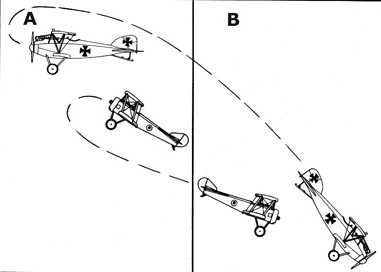
After attacking from underneath (A), Pup breaks off action and (B) heads down to intercept escaping enemy. Source: Original sketch by author from concept in Aerial Fighting 1917, TNA file # AIR 1/920/204/5/885 and aircraft drawings in Flugsport, June 1917, p.365 and L’Aérophile, June 1917, p.203.
To fill the need, suitable tactics permitting or promoting a second act were pursued. Consider one such officially certified RFC plan, starting with a Pup initiating an ordinary “single-seater method of attack, from below.”14
Expecting the routine turn-and-dive response of his Albatros target, the recommended countermove for the Pup was not to follow its foe into the usual right hand climbing circle. Instead, the Pup was to dive towards the expected Albatros exit trajectory. If the Pup pilot proved fortunate in his prediction and timing, the Albatros would come hurtling by, permitting a second attack.
The drawback was one of uncertainty concerning the enemy’s future path. Just as predicted, somewhere along its evasive turn, the Albatros would likely peel off and dive. Though the dive itself was a good bet, the compass heading of the dive was far from certain, and any estimate by the Pup pilot so much guess work. With only a limited ability to shift heading at the last moment, the Pup was unlikely to intercept with the necessary degree of precise shooting. In short, a Pup following this tactic would find success unlikely.
In rebuttal, it might be argued that all tactical plans are built around an assumed enemy response, and that no such prediction can ever be certain. True, but we suspect that this particular tactic leaned too heavily on predictive ability, and so had more to do with hope than reality – proof that the need for a second act was a powerful motivating force.
More realistic second act plots did exist. For example, after completing a conventional “above and behind” type of shooting attack, a zoom plus Immelmann turn could be used to prepare for a second act – one of simple repetition. This well known procedure, dating back to 1915 and the Fokker E-III, was made more effective by the Pup’s power and maneuverability. The difficulty was in limited application, for the move was only too obvious and therefore fully expected. Any wary, uninjured and unrestrained enemy scout would be long gone before the second attack could be driven home. Even so, there always were enemy pilots unable to flee; for example, those too frozen, or too injured to react effectively; or those flying severely damaged machines; or pilots restricted to guard duties forbidding simple departure. Such unfortunates made perfect victims for second acts based upon the Immelmann turn.
Though Pup maneuverability proved helpful to the performance of second acts, bringing about a fresh solution was beyond its range. The search for successful second acts continued, but in real life these were usually too difficult to bring off against a wise and wary opponent equipped with a lively aircraft. The Pup would achieve more in a different area.
It was within the realm of defense tactics that extreme maneuverability registered most strongly. Employed in defense, super maneuverability coupled with adequate performance proved extremely successful, forcing reluctant doubters – including Richthofen – to change their views. The simplest defense tactics – those of ducking, weaving, jinking, and yawing so as to spoil the aim of aggressors – were speeded by high maneuverability, greatly increasing their effectiveness and preventing aggressor success.
If we imagine an attacker positioned to fire, equipped with a gun firing at a maximum rate of 10 bullets per second, a two second period spent by his target plane in carrying out an evasive move might result in a number of bullets approaching 20 sent its way. The same burst, fired at a livelier aircraft able to carry out its evasive maneuver in half the time, would receive only half of the bullets before moving out of harm’s way. i.e., only the first half of those fired would have a chance of hitting. As an additional advantage, this initial batch of bullets usually lacked tracer or visible damage guidance, for the correction of aim depended upon visual feedback gained from the rounds fired. Lacking aiming correction, such early rounds were likely to be less accurate than later ones. In sum, not only were the number of rounds capable of being directed at the target aircraft reduced by greater maneuverability, but even this lower number consisted of rounds lacking in aiming correction, and so were less likely to hit their target.
Maneuverability’s profits involved more than a lessening of properly aimed incoming rounds. In certain cases, a fast maneuver could take a defending aircraft completely out of the line of fire, ending the attack. As an example, consider the use of a full roll to wash out a prime “above and behind” attack.
Given a Pup about to come under diving attack from the well placed enemy machine shown, RFC advice for its pilot was to execute a full roll in the conventional fashion, with stick full back and over to one side, employing full rudder on the same side. During and after rolling, the machine would continue in the same direction. However, the extra drag and loss of lift experienced in the maneuver would cause both an altitude drop and a relative decrease of distance traveled. As a result, the enemy Albatros was out of position for effective shooting, being both too high, and too near in the horizontal sense. The latter was viewed as especially important. Relative to the Pup, the Albatros had been forcibly repositioned to an “overshot” condition, with its attack effectiveness eliminated, and all done by a quick maneuver.
In short, for scout machines flying defensively, extreme maneuverability plus a wary, skilled pilot meant a much smaller chance of being killed. To pilots desperate to survive, the necessary path was clear: all other things being equal, go with more aircraft maneuverability. Even if other things were not equal – for example, if a bit of speed had to be sacrificed in the name of maneuverability – there was still much to be said for superior maneuverability.15
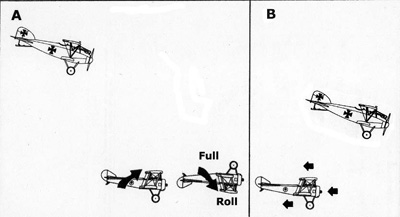
To defend against an attacking Albatros (A), the Pup employs a full roll and (B) continues in the same direction. The maneuver reduces the horizontal distance from the attacker sufficiently to prevent accurate shooting. Source: Original sketch by author from concept in Notes on Aerial Fighting, TNA file # AIR 1/2087/7/38 and aircraft drawings in Flugsport, June 1917, p.365 and L’Aérophile, June 1917, p.203.
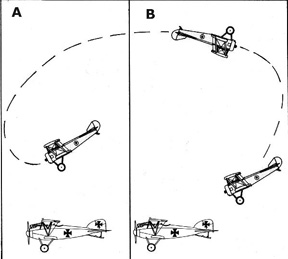
To attack an aircraft directly below (A), a backwards loop (B) could be used to place the aggressor right behind his target. Source: Original sketch by author from concept in Fighting Instruction Data, TNA file # AIR 1/1625/204/89/8 and aircraft drawings in Flugsport, June 1917, p.365 and L’Aérophile, June 1917, p.203.
Moving energetically to experiment with its new capability, the RFC managed to find a most practical use for the loop – of all maneuvers, the one most despised by Richthofen.
Instructions to new pilots were detailed:
Suppose a Hun [i.e., enemy aircraft] is just under you … do a ¾ loop and then rudder straight. You will be sufficiently high to get a good dive on him … you must be going full speed before starting, as otherwise you are bound to stall at the top … remember the machine has sufficient speed … so there is nothing to worry about.16
The note of determined optimism suggests that there was at least one thing to worry about – adequate speed. With Pup power a bit low for the task at hand, all had to be just right for the maneuver to succeed. Yet it did succeed, and frequently enough at that, to become a trick flying standard. One year later, the arrival of newer, more powerful scout aircraft resulted in routine use of the backwards loop. For example, there was Captain Eddie Rickenbacker and his SPAD XIII, who successfully wiped an attacker off his tail with the backwards loop maneuver, and then followed up with a most satisfactory reversal-of-roles form of act two: “one short burst from both my guns and he tumbled down … ”17
The SPAD XIII’s great power – well over 200 h.p. as compared to the Pup’s 80 or 100 – led to a machine offering not only superb maneuverability, but offered additional speed and climb advantages as well. Those pilots attracted to maneuverability but hesitant to go with the Pup’s barely sufficient power found the packaging of extra speed and climb along with maneuverability to be a complete answer. Ever since, fighter design has pushed all three virtues as critical.

Despite Richthofen’s initial skepticism, evidence before his own eyes convinced him of maneuverability’s ability to improve survival odds. Trick flying could pay off – and handsomely at that. This bitter truth was forced upon him in April 1917 when the Pup’s successor, in the form of a single Sopwith Triplane, frisked about over German held turf despite attacks from the full complement of his own Jasta 11’s pilots and machines.18 The achievement was extraordinary: a single scout had easily fended off a squadron of experienced fighters. This time, Richthofen did more than make a note.
Always able to change his mind when logic so insisted, he studied the case for maneuverability as offered by the Sopwith Triplane, and decided that it deserved support. Given time, maneuverability might change the game. He became an active triplane supporter. Using his new found prestige, he pressured the German Air Service to study and even copy the Sopwith Triplane. He helped push the notion that air flow about three wings was wonderfully effective, with supremacy proven by the Sopwith’s performance and maneuverability. The belief was mistaken. In reality, triplane wing configurations are inefficient.19
Nature taxes every wing tip heavily. Carrying six wing tips, every triplane aircraft pays a steep price in the form of lowered flight efficiency. Added on is another type of loss, that owing to mutual interference by wings in close proximity, for unfortunately, each wing roils the air through which its brother wings pass. The single wing monoplane is best – there are no brother wings – biplanes less so, and three wings pay a considerable interference price. Taking all losses into account, triplanes tend to offer high drag. This inherent tendency can’t be eliminated, no matter how clever the designer.
There are offsetting triplane advantages. A most thorough 1916 British aerodynamic wind tunnel investigation20 pointed to the use of stagger, i.e., a fore and aft displacement of the upper wings relative to the lower, as a means of offsetting the interference loss. However, to achieve a significant benefit, much stagger was required. In the case of the Sopwith design, one side effect of the great stagger employed was curtailment of the pilot’s vision, with cutouts of the middle wing necessary to permit adequate sight. As for the aerodynamic benefit, it was paid only at extremely low speeds, at or near stall, by making flight more viable. The classic circular duel was such an occasion and survival itself could conceivably be influenced by the presence of large stagger. However, when at typical combat speeds, there was no benefit, and top speed itself was lessened by the triplane wing drag, with or without stagger.
For a triplane to be competitive against the usual monoplane or biplane design, it was necessary that something extra be thrown in as compensation. In the case of the Sopwith design, an engine change from the Pup’s 100 h.p. Monosoupape, initially to 110 h.p. and then to a more powerful 130 h.p. Clerget, more than compensated for the Sopwith Triplane’s reduced wing efficiency. The resulting climb was striking, and its speed (116 mph)21 exceeded the maximum velocity of the Albatros D-III (108 mph).22 Finally, through careful weight control, much of the Pup maneuverability was retained. All in all, the machine was impressive – despite the disadvantages of the three-wing arrangement.
Richthofen’s push for a triplane, beginning in April 1917, encountered little enthusiasm within the German aerodynamic establishment. Researchers were aware of the negative British triplane experimental findings and had strong additional reasons, based on sound theory, to doubt triplane effectiveness. The conflict grew until management was forced to resolve the issue: wanted was a means to placate both Richthofen and the aerodynamicists. Here was a perfect opening for that much-maligned designer, Anthony Fokker.
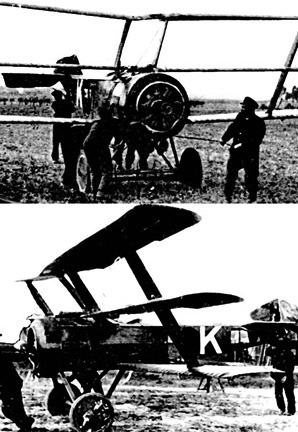
A downed Sopwith Triplane drew much attention from German Intelligence. Note large forward wing stagger. As for the missing insignia patches, they likely graced the victorious officer’s mess. Source: Flugsport, August 1917, p.517.
Despite the great success of his E-III, succeeding months had seen Fokker become something of a liability, cursed by a string of unsuccessful follow-on designs, poor workmanship at his factory, and his inability to keep up with the increasingly mathematical nature of design work As a last straw, a false scandal23 arose concerning his Dutch (neutral) citizenship involving a loony, imaginary plot featuring an escape to Britain, where rumor had it, he would be well paid to reveal German military secrets.
Though his reputation suffered, he continued to hold the respect of most pilots for reasons of great flying skill and open-handed support. Former exhibition and stunt flyer Fokker knew the flying game from the inside. To fellow pilots he was that rarest of men: a full-scale manufacturer, still in his twenties, young enough and sufficiently at odds with the establishment to understand their problems. Added to this agreeable background was a rare generosity suggesting something else, for Fokker was always ready to offer a trial flight in his latest machine at the Schwerin factory, or better yet, a hotel room in jammed Berlin – at no charge. Moving beyond “hospitality suite” largess, Fokker has been accused24 of bribery; of openly buying the support of his most important customers: not official purchasing agents, but fighter pilots.
As the rumors grew, the atmosphere surrounding Fokker became difficult. To have one’s design hopes assigned to Fokker for implementation was not a good sign. Any Fokker linkup implied low expectations from top Air Service management.
An undaunted Tony Fokker, given the go-ahead to proceed with a triplane, turned the design process over to Reinhold Platz, a holdover from the days of trial and error, whose background was that of a welder. Though his knowledge of advanced theory was weak, few could match his intuitive feeling for practical design; a creative sense that approached genius. Once satisfied that a triplane was under way, Richthofen stepped back to concentrate upon combat as before, flying standard service biplane fighters. To Fokker, this was for the best, for “Richthofen knew little or nothing about the technical details of airplanes.”25 Perhaps, but as the British would learn, Richthofen knew a great deal about what could be done with airplanes – especially fighter aircraft.
Returning to a form of combat that was basically unchanged, Richthofen continued to blast the standard opposition British observation, fighters and light bombers: BE2c, FE2b, RE8, etc. To defeat such opponents, great maneuverability wasn’t required. Certainly his 1917 victories owed little to the presence (starting in September) of the Fokker Triplane. As for the relatively maneuverable Sopwith Triplane, so impressive to Richthofen, they were few in number and rarely encountered. Only one combat victory over a Sopwith Triplane has been assigned to Richthofen (victory # 52 on April 29, 1917)26 and even that sole conquest was clouded by evidence suggesting that the defeated machine was really a Nieuport biplane.27
Richthofen Victories per month: April 1917–April 1918
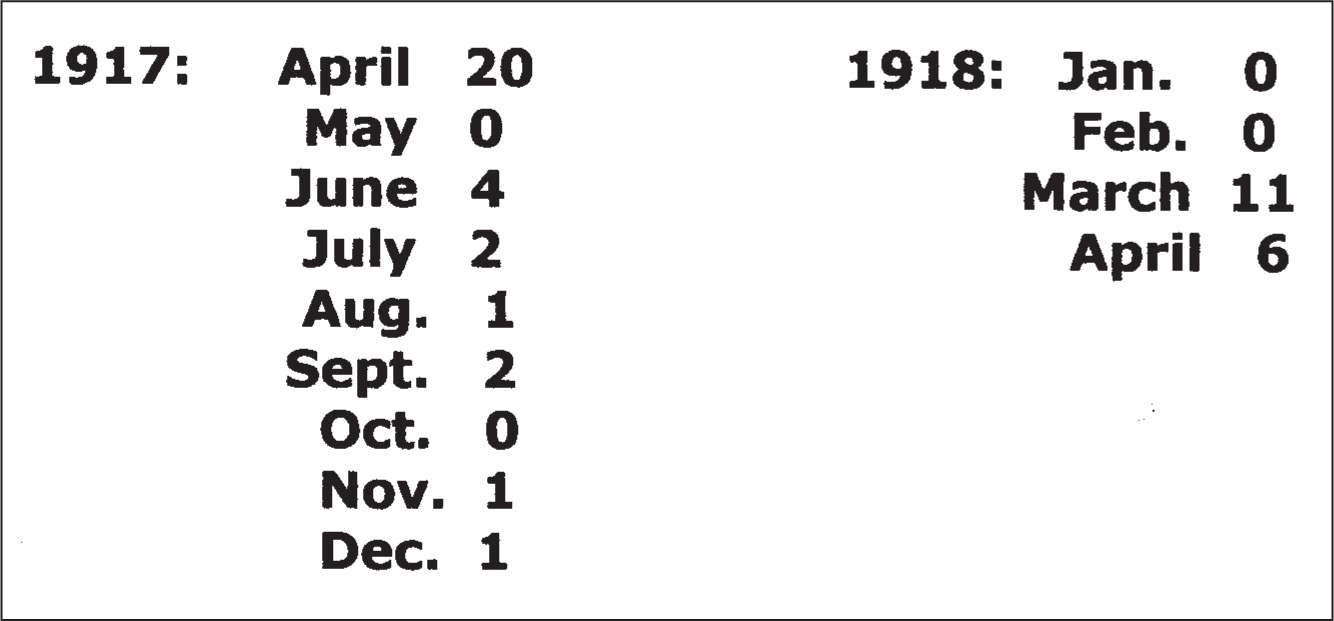
From “Bloody April” 1917 until his death one year later, monthly victory numbers depended on infantry thrusts, leave and weather. He used the Fokker Triplane almost exclusively starting in September 1917. Source: Author’s list from data in L’Aérophile, April 1918, p.110.
British disappointment in triplanes is suggested by the total of only 150 Sopwith Triplanes manufactured, curtailing its combat life to a short period – seven months28 of 1917 – in which some 40 of the type were claimed as downed in combat.29 Grounds for disappointment certainly existed. The Sopwith Triplane was handicapped, not only by the inherently modest top speed demonstrated by all three-winged aircraft, but by the effects of excess stability as well, preventing the machine from making full use of its maneuverability potential. In reality, there was but one extraordinary feature: a high rate of climb. To the British, Sopwith’s sibling biplane – the Sopwith Camel – was a better fighting machine. Not only did its two wings yield a superior speed for a given amount of power, but it enjoyed maneuverability advantages as well; those derived from instability. These took the form of quick movements, wanted or not, and so were frequently dangerous. To pilots, the tradeoff was acceptable, for speed plus maneuverability spelled victory, and even that sick maneuverability owed to instability was better than the slow, safe, graceful maneuvers granted by the Sopwith Triplane. Inevitably, the Sopwith Triplane was phased out in favor of the Camel.
Unlike the Sopwith firm, the Fokker/Platz team was in no position to shrug off the three-wing concept as less than optimal, and so not worth pursuing. While a correct judgement, such reasoning pre-supposed a free choice between a biplane or triplane. Fokker had no such choice available. Wanted by the German Air Service was a world beating triplane fighter, and his only alternative was to continue building trainers on sub-contract, a venture he detested. He sensed the triplane challenge as a chance to regain world respect as an inventor and innovator. He pushed hard, using every skill and bit of trickery he possessed.
First, it was necessary to beat the competition: either match or excel those Sopwith traits that had excited Richthofen. There were two positive features: climb and maneuverability.
Climb was mostly a matter of weight, wing area and engine size. To save weight, streamlining was abandoned. All lines were simple and straight. As for the drag penalty – so be it – triplanes were innately slow anyway. Next, the resulting machine was made as small as possible, effectively scaling up the modest engine power while simultaneously reducing weight. As for the welded fuselage plus wooden wing construction, though intrinsically sound, they were demanding; perfectly adequate if carefully done but only marginally safe, with little spare strength left over. Executed by unskilled wartime labor, and guided by slipshod quality control measures, this optimistic design process could lead straight to wing failures. Its dangers unheeded, the work went on.
Those thin wings used by Sopwith, low in drag, were dropped in favor of high drag, thick wings. The one virtue of thick wings was the greater thickness itself – permitting use of deeper and more efficient spars to carry wing loads. With the light spars made possible by fat wing sections, overall wing weight was reduced – a significant step in achieving a low weight machine. It was even possible to eliminate all the usual bracing cables (lift wires) along with their requirement for endless adjustment. As for the additional drag entailed by fat wings – it was accepted with a shrug.
So critical was weight that range and flight duration were deliberately cut to reduce fuel weight. Proud of this questionable expedient, an unrepentant post-war Tony Fokker argued that Allied airmen had acted unwisely by not “outwaiting the Triplane, which carried less petrol, and then with their greater speed, running them down.”30
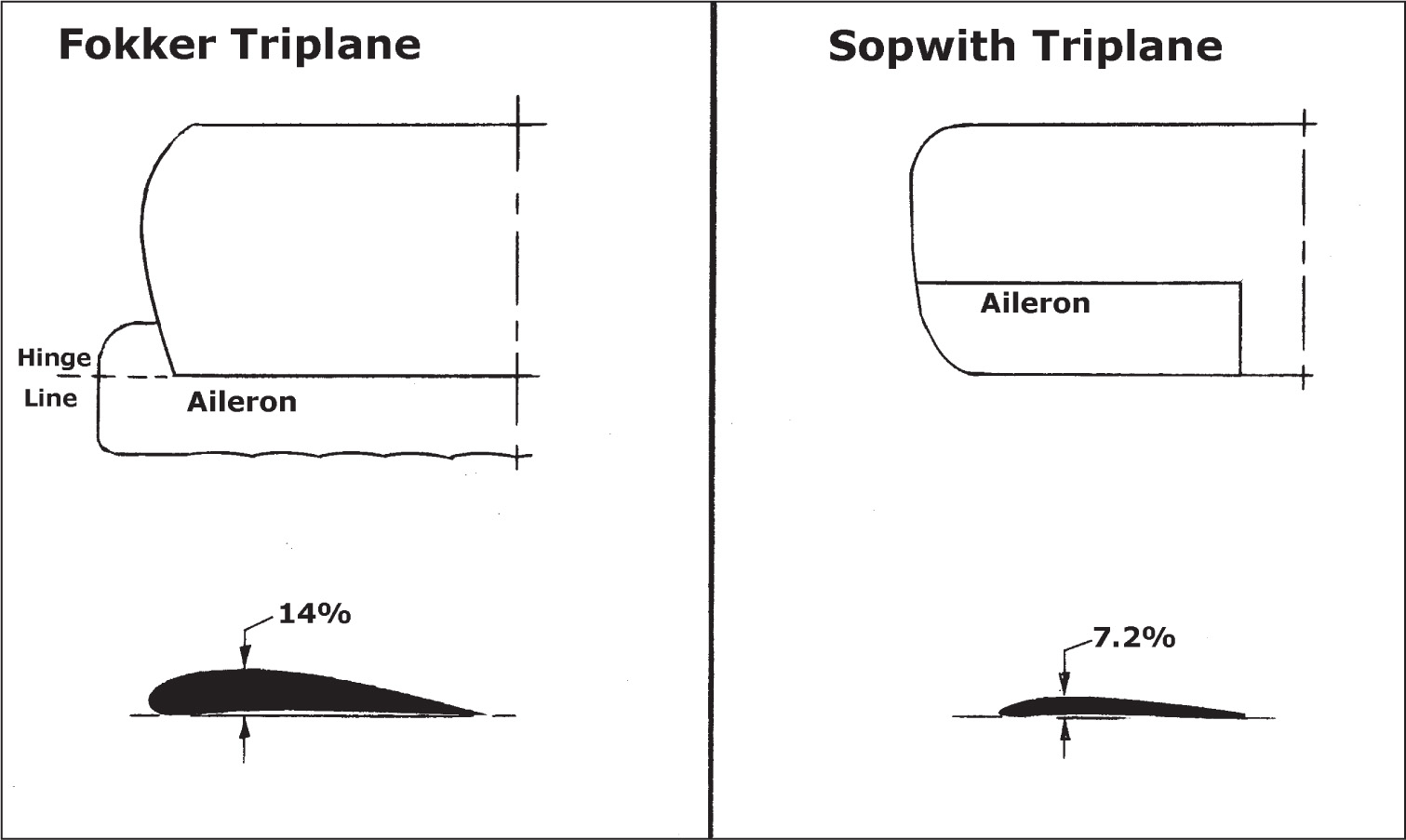
Rejecting Sopwith’s design, Fokker employed a thick wing carrying deep spars, together with balanced ailerons. He hoped for a lightweight result offering fast banking. Source: Original sketches by author, redrawn from Flugsport, March 1918, p.104 and Flight, May 30, 1918, p.586.
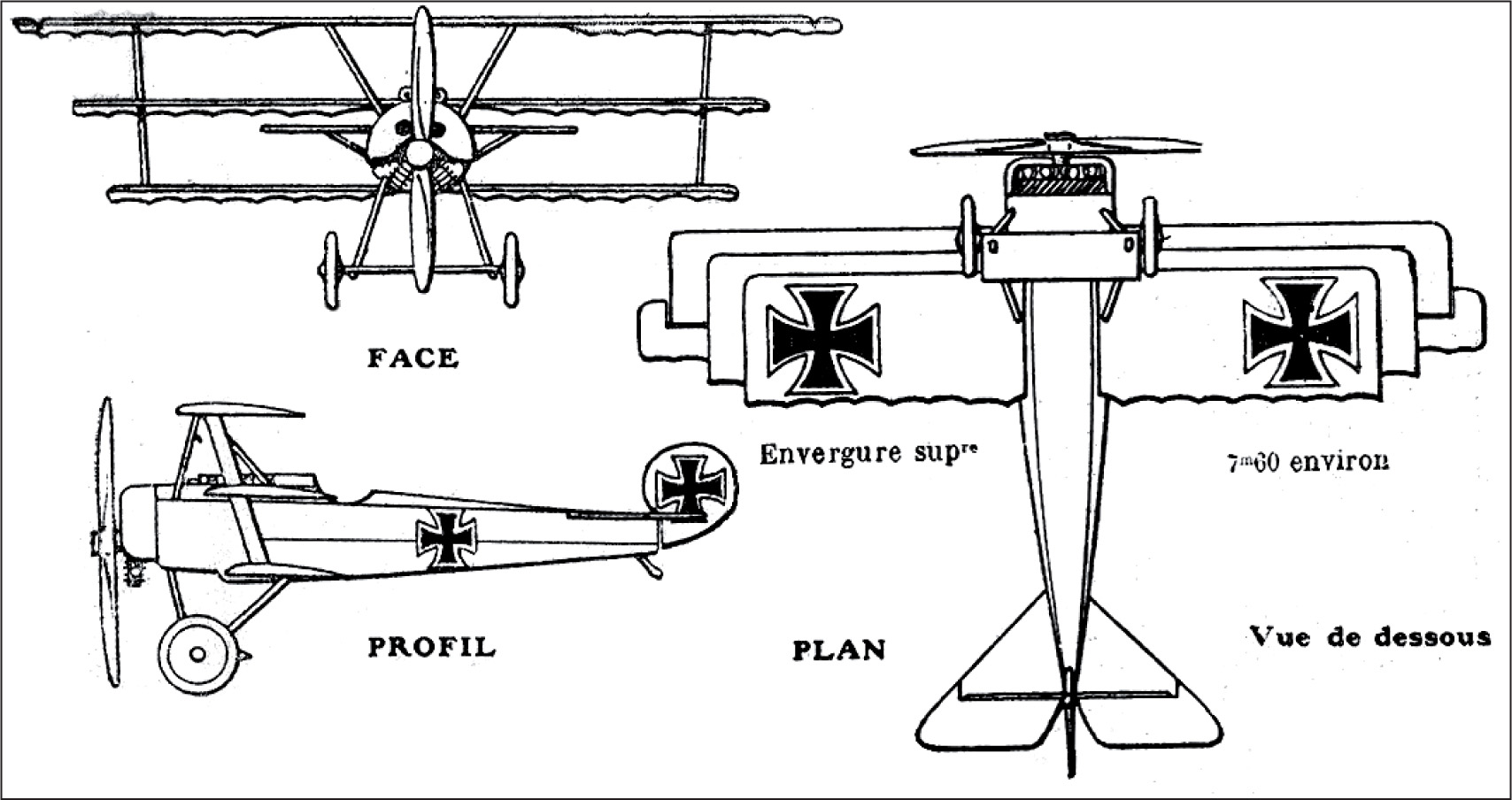
Contemporary French sketches featured a rare bottom view. Note lack of dihedral and absence of a fixed fin. Maneuverability was wanted–not stable flight. Source: L’Aérophile, March 1918, p.65.
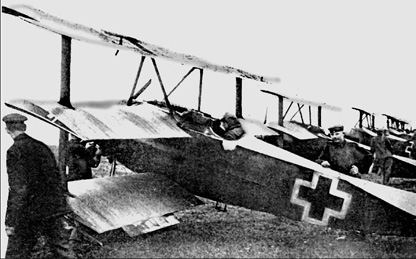
Unmoved by his satisfied mechanic (extreme right), a pilot readies his Dr.I by checking off the pre-flight list. Source: Flugsport, July 1918, p.344.
Maneuverability was to come from the low all-up weight, yielding a small wing loading, and even that minimal weight was tightly concentrated to achieve lower inertial forces. Aileron, rudder and elevator control surfaces were large and balanced, an arrangement hopefully requiring less piloting input and yet yielding the fastest possible operation. From the unusual aileron balance extension, much was expected in the way of quick banking, but post-war tests31 revealed major drawbacks. When at small angles of wing incidence, all was well and the balancing forces generated were of a useful size. However, in this situation the pilot required no boost and so the gain was unimportant. When help was really wanted – at large angles of incidence, as in climb or bank – control stick forces were reduced only for small amounts of aileron displacement. Large displacements not only failed to produce any reduction in stick force, but led to stalled, burbling flow about the aileron, producing a large drag force tending to break off the overhanging portion of the aileron.
In short, the Fokker Triplane aileron balance did little good and could well become a serious detriment, either by reducing performance when maneuvering, or through breaking apart when heavily loaded. The NACA evaluation carefully concluded that use of such a balance “on any highly maneuverable airplane is not recommended.”32 In practical terms, the Triplane aileron balance was a bad idea. Yet, so great was the wartime drive for quick completion of the Triplane that the balanced aileron continued in place without question. Indeed, design momentum was so great that the notion continued beyond the Triplane. Despite growing evidence that the aileron balance was a poor idea, it was also employed on the succeeding Fokker D.VII biplane.
In the midst of the headlong rush for an acceptable Triplane, Richthofen suffered a major reverse of his own. Flying an Albatros, he was shot down on July 6, 1917, suffering a severe scalp wound, hit by a bullet to the head. Though key details of the engagement remain uncertain,33 he was most likely hit by the gunner of an FE2 in an otherwise routine fight. The wound produced momentary blindness and paralysis, resulting in a crash landing. Hospitalization followed. Yet he was back in action one month later, downing his next victim (victory # 58) on August 16.
The life-threatening nature of Richthofen’s wound has produced speculation concerning his subsequent state of mind. Evaluation is difficult. Every fighter pilot was under great stress. Headaches, too much alcohol, and violent temper tantrums were standard reactions. In Richthofen’s case, no clear sign of unusual fear, depression or poor judgement was apparent to his peers. Were it otherwise, the standard military solution would have been employed: long leave and transfer to a desk. That he continued to lead men in combat was a sign of acceptable mental and physical health, as measured by the standards of his time.
In the meantime, after many changes the emerging Triplane was submitted for preliminary stress and performance testing in mid-August 1917. The prototype’s carefully constructed wings passed with a high safety factor – if properly built, the wing structure was more than strong enough.34 By late August the Triplane was officially approved and in service.
An early recipient was Leutnant Werner Voss, commander of Jasta 10. A believer in aerobatics, he was pleased with the light, frisky and fast climbing Triplane. Here at last was a German machine sufficiently maneuverable to put the case for aerobatic combat to the test. Starting on August 30, 1917, he succeeded in downing 21 enemy aircraft by September 23 – an awesome achievement. He was then brought down in a fight against at least five SE5a machines; a fight he could have avoided had he not full confidence – too much confidence – in his Triplane. Even if not equal in ability to five of the top British aircraft, the Triplane was very good indeed.
Richthofen’s experience backed that of Voss. In early September, victories 60 and 61came with the aid of the new Triplane. Furthermore, he was impressed with the September exploits of his friend Voss. All seemed fine. However, with the delivery of the next batch of machines in October, the Fokker curse returned. In separate incidents, Leutnants Heinrich Gontermann and Herbert Pastor were killed when engaged in moderate stunting over their home fields. Wing failure was the cause in each case. Richthofen, a witness to the Pastor death, called for a close inspection of all the new Triplanes. The results were disturbing: the wings displayed shoddy workmanship everywhere, and factory inspection was obviously non-existent. Especially poor were wing rib and aileron construction techniques.
Richthofen was at a great divide. The Triplane was clearly a highly mixed blessing, presenting many problems. Good men were dead owing to its irresponsibly defective construction, and the correction of its manufacturing flaws would take many months. The war wouldn’t wait. In the meantime, he was forced to continue use of the Albatros series of fighters; well built, if unexciting machines that had served him well, but smacked of the past.
We don’t know his thoughts, but he must have considered certain possibilities. Surely it occurred to him to drop the Triplane, or Dr. I (official designation), as coming from a too deeply troubled Fokker manufacturing source. Instead, he could simply continue with the Albatros series, or perhaps choose another sound biplane, manufactured by a proven source.
In making his decision, one important item was the matter of engine superiority. In contrast with the superb in-line Mercedes engine of the Albatros, the Dr. I’s rotary Oberursel engine, like most rotaries, was less certain in operation and subject to seizure. True, the rotary engine was light, and this quality led to a highly maneuverable machine with a superb rate of climb, but what of its relatively low power output? How could the Dr. I dominate combat if enemy aircraft could readily outspeed it?
As for Voss and his series of victories employing the Dr. I – yes, the facts were impressive – however, Voss had a feeling for trick flying that bordered on genius. Even the British thought so.35 What of the typical pilot with his limited skills? How would the demanding Triplane serve him? For that matter, what of Richthofen? Though endless practice had improved his flying skill, he would never match Voss in ability. Would he really profit by switching from his customary “above and behind” attack pattern to the “catch as catch can” format of the maneuverability advocates?
Then, what of the politics of combat and its influence on tactics? The Army had steadily pressed for the right personal attitude, rather than gadgetry, as the key to victory. Infantry officer and fellow Pour le Mérite holder Leutnant Ernst Junger reflected this view: “Security rests on the fresh and unwearied courage of its defenders, not on the strung-out … approaches or the depth of its fire trenches.”36
Richthofen’s corresponding statement was a good fit: “The decisive factor does not lie in trick flying but solely in the personal ability and energy of the aviator.”37
To the Army these were useful expressions of the right attitude. So long as the typical soldier lived and fought in muddy holes, to suggest some form of sophisticated trench building or flying machine as necessary for survival could produce unrest. To Air Service General Ernest von Hoeppner, Richthofen’s contribution was one of “ … steadfast purpose … fine modesty, frank and knightly bearing … ”38 Nothing was said about campaigning for a special breed of extremely maneuverable Triplanes as the way to win.
Finally, if he changed tactics and pushed hard for maneuverability, what of his The Red Air Fighter book, just published and carrying only his previous views condemning trick flying? True, they were only words, but to sophisticated readers, switching course by 180 degrees would make him look like a fool. Was this to be borne?
Yes, it was. What mattered was winning in the future, not the past. Maneuverability plus climb and speed was the way to win and nothing else mattered. Had he not cheerfully abandoned the horse cavalry, despite years of training, when it proved unequal to a machine gun war? Just so the decent and carefully constructed Albatros series must go. Of the big three performance requirements, it offered only speed, and speed alone wouldn’t do.
Fokker and the Triplane it would be, despite Fokker’s questionable production capability. With the Dr. I there was a chance against the just emerging Sopwith Camel. Without it, there was none. As for the Triplane concept itself, the main drawback was one of low speed. Here Fokker had some interesting ideas about a new, highly maneuverable biplane. If given a Mercedes engine, fat airfoils and the design genius of Platz, perhaps something rivaling the Triplane could be prepared in a faster biplane format. It must be tried.
Maneuverability had triumphed, despite Richthofen’s strong initial doubts. As for suitable tactics there were, not Boelcke’s many rules, but only one: catch as catch can.